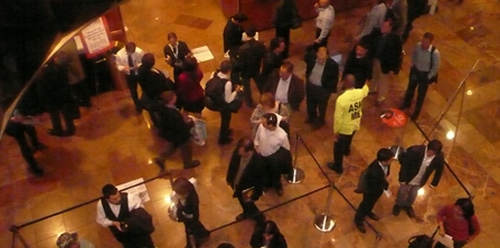
In this SES New York session, veterans of the first online marketing downturn discussed strategies that helped them survive those difficult times and how they intend to continue to survive and thrive. The Moderator is Sara Holoubek, Consultant, Columnist and SEMPO Board of Directors.
Speakers/Panelists: Bryan Eisenberg, SES Advisory Board, Co-Founder, Future Now, Inc., Jason Ciment, CoFounder, LaDezign.com, Bob Myhal, President, MuscleMaster, and Kevin Lee, Co-Founder & Executive Chairman, Didit
Sara Holoubek facilitated a very spirited panel discussion that centered on the state of the Internet marketing food chain in 2009 and how it compared to 1999. She opened the session by asking the panel, “What were you doing in 1999?
BE: Doing some work in SEO. Went to an incubator and was told to “focus on your core strength”. And merrily down the path of “Conversion” he went.
JS: Was following Brian E like the pied piper. Started down the yellow brick road of “Conversion” and the rest is history.
BM: Was doing everything from building sites to packing boxes. Started building raw html sites.
KL: Transitioned from organic SEO into paid Search. Wrote a book about Best Practices in SEO.
The panel discussed the Economics 2009 vs 1999 and focused on a few key points.
• There are always going to be market fluctuations up and down. It is the people and businesses that act in these hard times that will get ahead and develop.
• A lot of competitors are falling by the wayside and so there are interesting opportunities to consider. Acquisition of competitors is one of the key opportunities that arise during tough economic times. Acquire (competitors) and leverage( market position and product value).
• Lifetime values (long term results) used to work but now you need to show immediate results to validate ROI.
• You must consistently look for new avenues. “Every time you transform your company your competitor set changes”. With the evolution of your business the market dynamics constantly shift and realign.
When in doubt, Think about the client. Showing your customers that you care for them and will go to the ends of the earth is great strategy and will go a long ways towards success.
• Your most valuable source for business growth is your existing client base and finding new ways to serve them. Be innovative, creative and nimble.
• Million dollar a month spenders share a philosophy of “Real success comes from constant execution.” “Measure and prove, measure and prove.”
The economy is Broken. Consumer confidence is at an all time low. What can we do?
• Keep customers happy. Communicate often with your client base.
• Become experts in particular industry niches. Focused disciplines.
• Get back to basics. The fundamentals of marketing and consumerism do not change. They evolve but they don’t change.
Key differences between 1999 and 2009
• Data is plentiful and immediate. Use it to your client’s advantage. Americans tend to be numerically illiterate and marketers need to invest in educating their client base to become Data smart.
• There has been a seismic shift in speed. Everything from bidding landscapes to execution of marketing plans relies on greater efficiency speed and nimbleness. The velocity of business today quickly weeds out those businesses that cannot react quickly enough. “You must learn to eliminate the losers faster.” KL
Looking ahead:
• Kill the crap in your campaigns. Don’t waste. “Verbosity kills velocity “(mine)
• Be ruthless. Eliminate Lazy money and make sure that you can measure, and target to support your ROI. Optimize your opportunities.
• Listen to your Customers. “Miles Davis was famous and admired not only for what he played, but how he used the silence between the notes.” JC
Brian Eisenberg then asked the audience “How many of you have set programs in place to improve your conversion rates?”
• 90% of all online traffic does not result in a conversion. It is critical to optimize the traffic you already have and look for improvements.
• Conversion enhancement does not stop at the Thank you page, It can occur at every single touch point (offline/online). You really need to target your sites and focus your messaging.
• Casting a broad net is becoming less and less effective.
Holy Content Batman!
The holy grail of SEO is getting content that is topical, valuable and relevant.
• The consumers post click experience is vital. How well do you engage them? Do you have the right content and experience in place to meet their demands and needs? Remember that it’s a 2 way street.
• Great content is king. It is getting much harder to compete through the “content noise” that currently gums up the web. The nature of content has shifted. If you value your customers you will provide valuable content.
• There is 40 times more competition for content than before and web traffic has increased a mere 3%. It is becoming tougher and tougher to successfully execute content rich sites.
• The whole search system has not changed much from 1999 except for one big change…Universal search (google). You need 5 times as much content to compete today as was required just 10 years ago.
Ultimatley is comes down to Basic Marketing principals. Satisfy the customer. They have more control in the buying continuum than ever before. Give them value and they will convert with you. Provide quality and engaging content and a valuable experience. Product reviews, blogs, some form of deeper engagement. This will help move customers forward in the buying process. In a nutshell:
• Be good to your customers
• Be innovative for your customers
• React to what your customers tell you
• Measure all of your actions and results
• Reapeat, repeat repeat.
The entire panel agreed across the board to get back to basics and remember that one size does not fit all. As true in 2009 as it was in 1999.








